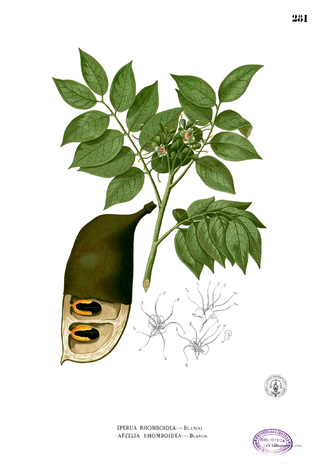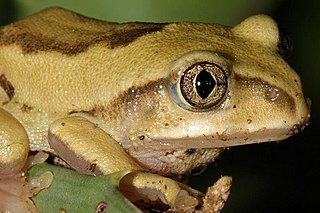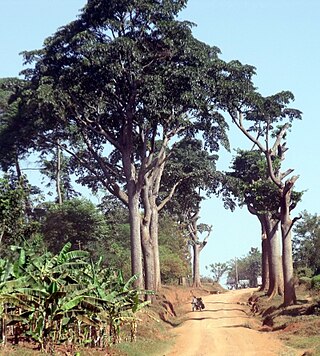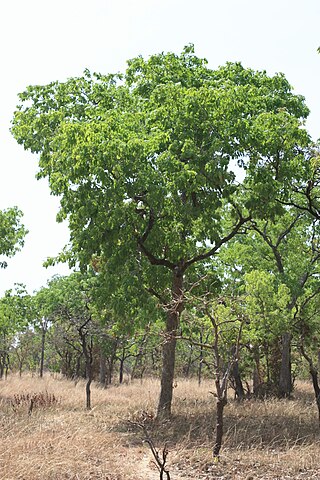
Afzelia is a genus of plants in family Fabaceae. The thirteen species all are trees, native to tropical Africa or Asia.

Entandrophragma cylindricum is a tree of the genus Entandrophragma of the family Meliaceae. It is commonly known as sapele or sapelli or sapele mahogany, as well as aboudikro, assi, and muyovu.

Afzelia xylocarpa is a tree from Southeast Asia. It grows in Thailand, Vietnam, Cambodia, Laos and Burma in deciduous forests. It can reach 30 metres tall with a trunk up to 2 metres in diameter in a mature specimen.

Triplochiton scleroxylon is a tree of the genus Triplochiton of the family Malvaceae. The timber is known by the common names African whitewood, abachi, obeche, wawa, ayous and sambawawa. The tree is the official state tree of Ekiti State, Nigeria.

Afzelia bipindensis is an economic species of tropical forest tree in the family Fabaceae. It is found in Angola, Cameroon, Central African Republic, Republic of the Congo, Democratic Republic of the Congo, Gabon, Nigeria, and Uganda. It is threatened by habitat loss.

Afzelia rhomboidea is a species of plant in the family Fabaceae. It is found in Indonesia, Malaysia, and the Philippines. It is threatened by habitat loss.
Englerodendron vignei is a species of tree in the family Fabaceae endemic to tropical West Africa. It is found in Ghana, Côte d'Ivoire, Liberia, and Sierra Leone. It is threatened by habitat loss.
Cassia aubrevillei is a plant species in the family Fabaceae. A forest tree of tropical West Africa, it is threatened by deforestation and unsustainable logging for timber. The bark of the tree has been investigated for antifilarial properties.
Garcinia epunctata is a tall tropical rainforest tree in the family Clusiaceae. The tree is known for growing on inselbergs found in moist tropical forests of West Africa, including Upper Guinean forests, Lower Guinean forests, and Congolian forests south through Angola, both coastal and inland forests.

Leptopelis mossambicus, the brown-backed tree frog, Mozambique tree frog or Mossambique forest treefrog, is a species of frog in the family Arthroleptidae found in Eswatini, Malawi, Mozambique, South Africa, Zimbabwe, and possibly Botswana. Its natural habitats are dry savanna, moist savanna, subtropical or tropical moist shrubland, subtropical or tropical dry lowland grasslands, subtropical or tropical seasonally wet or flooded lowland grasslands, swamps, freshwater marshes, and intermittent freshwater marshes. It is threatened by habitat loss.

Afzelia africana, the African mahogany, afzelia, lenke, lengue, apa, or doussi, is a Myrmecophyte tree species in the family Fabaceae.

Baillonella is a genus of trees in the family Sapotaceae. Baillonella toxisperma is only species in the genus. It is found in Angola, Cameroon, the Republic of the Congo, the Democratic Republic of the Congo, Gabon and Nigeria. Its natural habitat is subtropical or tropical moist lowland forests. It is threatened by habitat loss. The moabi tree's nut oil is a key component of Baka and other indigenous people's subsistence.

Khaya anthotheca, with the common name East African mahogany, is a large tree species in the Meliaceae family, native to tropical Africa.

Khaya ivorensis, also called African mahogany or Lagos mahogany, is a tall forest tree with a buttressed trunk in the family Meliaceae. It is found in Angola, Cameroon, Côte d'Ivoire, Gabon, Ghana, Liberia, and Nigeria where it grows primarily in lowland tropical rainforests. It is threatened by habitat loss.

Milicia excelsa is a tree species from the genus Milicia of the family Moraceae. Distributed across tropical Central Africa, it is one of two species yielding timber commonly known as ọjị, African teak, iroko, intule, kambala, moreira, mvule, odum and tule.

Pterocarpus santalinoides is a tree species in the legume family (biology) (Fabaceae); it is locally known as mututi.

Isoberlinia doka is a hardwood tree native to African tropical savannas and Guinean forest-savanna mosaic dry forests where it can form single species stands. The tree is exploited for its economic value as a commercial timber. The leaves and shoots of the tree dominate the diet of the Giant Eland in its range. The tree is a host plant for Anaphe moloneyi, one of the caterpillars that produces a wild silk, sayan, local to parts of Nigeria.
Isoberlinia tomentosa is a hardwood tree native to the African tropical savannas and Guinean forest-savanna mosaic dry forests. At one time this tree was disregarded as a useful resource, but with the selective felling of such valuable species as Khaya senegalensis and Afzelia africana, it is now better appreciated.

Gilbertiodendron dewevrei is a species of tree in the family Fabaceae, native to tropical rain forests in Central Africa. It is often the dominant tree species of the Guineo-Congolian rainforest. The timber is traded as limbali, and is used for construction, flooring and railway sleepers. It is also used for making boats, furniture, tool handles and joinery and for making charcoal.

Mansonia altissima is a species of tree native to western and Central Africa. It has the vernacular names of; African black walnut or African walnut.
















